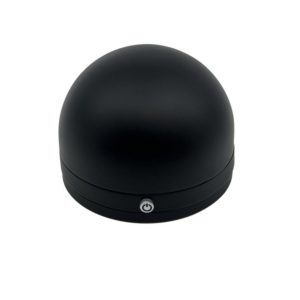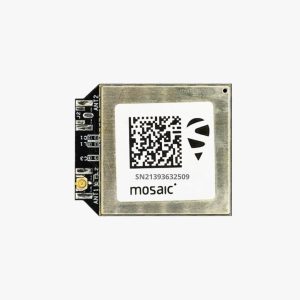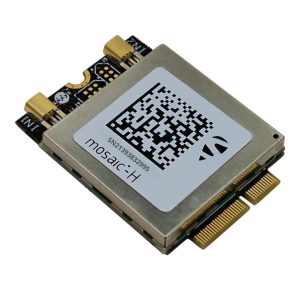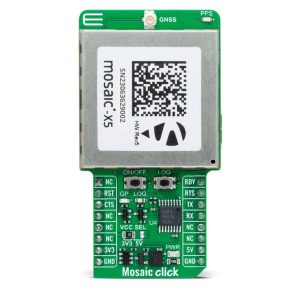Description
The Linnet Mosaic-X5 is a compact, high-precision GNSS RTK device, designed for multi-band and multi-frequency applications. Built on Septentrio Mosaic-X5 module, it ensures fast convergence and centimeter-level positioning accuracy. Supporting all major GNSS constellations—GPS, GLONASS, Galileo, BeiDou, NavIC, SBAS, QZSS, and L-band correction services—the module is a versatile solution for advanced positioning needs.
Achieve exceptional RTK precision with centimeter-level accuracy, even in low-coverage areas, thanks to its cutting-edge 448-channel receiver and robust support for “all-in-view” GNSS signals. The module is compatible with advanced correction services such as RTCM v 3.x, SSR, and PPP technologies, offering enhanced flexibility. Featuring a USB-C interface for fast data transfer and UART/USB communication modes, the Linnet also boasts onboard intelligence with a powerful CPU for internal web UI and NTRIP configuration.
Designed for resilience, the module incorporates anti-jamming and anti-spoofing technologies alongside a spectrum analyzer to ensure consistent performance in harsh environments. Its durable design enables reliable operation under extreme vibrations, shocks, and temperature ranges (-20°C to +70°C). Lightweight and portable, the Linnet comes with a protective case for easy transport.
With open-source compatibility and JST-GH connectors suitable for PX4 and ArduPilot devices, the Linnet Mosaic-X5 is an ideal choice for applications demanding accuracy, reliability, and versatility, whether as a rover or a base station.
Linnet Mosaic Specifications:
- GNSS: GPS L1/L2/L5 & Glonass L1/L2/L5 & Beidou B1/B2/B5 & Galileo e1/e5/e6
- Working voltage: 5V
- Current consumption: ~500mA
- Communication interface: USB/UART
- Weight: 0.15 kg
- Dimensions: 5.25 × 6.61 × 2.64 cm
MOSAIC-X5 module features:
- 31.0 x 31.0 x 4.2 mm LGA package
- Supports all-constellation multi-frequency on-chip RTK positioning and dual-antenna heading solution
- Supports GPS L1/L2, BDS B1I/B2I/B3I, GLONASS G1/G2, Galileo E1/E5b and QZSS L1/L2
- All-system multi-frequency RTK engine and advanced RTK technology
- AIM+: Industry-leading Anti-jamming, Anti-spoofing Interference Monitoring and Mitigation
- IONO+: Advanced protection against ionospheric disturbances to GNSS signals
- APME+: a posteriori multipath estimator for code and phase multipath mitigation
- LOCK+: superior tracking robustness under heavy mechanical shocks or vibration
- RAIM+: Advanced Receiver Autonomous Integrity Monitoring
Performance Specifications:
Frequency
- GPS L1C/A, L1PY, L2C, L2P, L5
- BDS B1I, B1C, B2a, B2b, B2I, B3
- GLONASS L1CA, L2CA, L2P, L3 CDMA
- Galileo E1, E5a, E5b, E5 AltBoc, E6
- QZSS L1C/A, L1C/B, L2C, L5
- Navic L5
- SBAS: Egnos, WAAS, GAGAN, MSAS, SDCM (L1,L5)
- On-module L-band
Single point positioning (RMS):
- Horizontal: 1.2 m
- Vertical: 1.9 m
- Time Precision(xPPS out) – 5 ns
- Data Update Rate: 100 Hz
DGPS (RMS):
- Horizontal: 0.4 m
- Vertical: 0.7 m
- Cold start < 45 s
- Initialization Time < 7 s (typical)
- Data Update Rate: 100 Hz
RTK (RMS):
- Horizontal: 0.6 cm + 0.5 ppm
- Vertical: 1cm + 1 ppm
- Data Update Rate: 100 Hz
- Differential Data – RTCM V2.x, V3.X (MSM included), CMR v2.0/CMR+ (input only)
- Data Format – NMEA-0183, v2.3, v3.03, v4.0, RINEX v2.x, v3.x, Septentrio Binary Format (SBF)
Physical Characteristics:
- Packaging: 239 pin LGA
- Dimension: 31.0 × 31.0 × 4.2 mm
- Weight: 6.8g
Environmental Specifications:
- Working temperature: -40 °C ~ +85 °C
- Storage temperature: -55 °C ~ +85°C
- Humidity: 95% No condensation
- Vibration: MIL-STD-810G
Communication Interfaces:
- 4 × UART (3 with hardware flow control)
- 1 × USB (2.0, HS)
- 1 × Ethernet (RMII/MDIO), 10/100 Mbps
- 1 x SD memory card
- 2 x Event inputs
- 2 x GPIO
- 1 x PPS out
Key Features of Linnet Mosaic:
Centimeter-Level Precision: Real-Time Kinematics (RTK) allows the receiver to reach unmatched accuracy, providing centimeter-by-centimeter location. It is perfect for precision-dependent applications because of its sophisticated capabilities, which guarantee outstanding performance even in settings with weak or obstructed signals.
Advanced Mosaic-X5 Receiver: All of the major GNSS constellations, including GPS, GLONASS, Galileo, BeiDou, QZSS, NavIC, and SBAS, are supported by this GNSS receiver, which is based on the Mosaic-X5 GNSS receiver. It optimizes satellite visibility with 448-channel “all-in-view” tracking for reliable precision. Furthermore, it supports corrective services such as SSR, PPP, and RTCM v3.x, guaranteeing flexible deployment across a range of operating requirements.
High-Performance Hardware: With USB-C connectivity, the device provides accurate and quick data transfer. Its robust CPU makes setup and USB monitoring easier with its integrated web user interface and onboard NTRIP client/server. Additionally, the hardware supports a variety of communication channels, such as USB and UART, offering a wide range of connectivity choices.
Enhanced Resilience: The gps receiver has anti-jamming and anti-spoofing features built in for exact and secure functioning. Its robustness is further increased by an inbuilt spectrum analyzer, which guarantees reliable GNSS tracking even under trying circumstances with strong shocks and vibrations.
Compact and Portable: The device is ideal for field applications due to its lightweight and small design. Included is a protective case, which gives users on-the-go an additional layer of resilience.
Applications of Linneter Mosaic-X5:
Precision Agriculture: For operations like yield mapping, precision planting, and auto-steering tractors, attain centimeter-level accuracy. Even in difficult field situations, increase production with dependable RTK location.
Unmanned Aerial Vehicles (UAVs): For precise aerial mapping and surveying missions, integrate with UAVs. Take advantage of strong GNSS tracking, even in places with poor signal strength or interference.
Surveying and Mapping: Perfect for collecting geospatial data, cadastral mapping, and land surveying. supports RTCM, SSR, and PPP, three contemporary correction methods, to guarantee accurate and dependable results.
Autonomous Vehicles: Improve robotics and driverless car navigation systems. Protect against spoofing and jamming to ensure resilience and safe operations.
Telecommunications and Timing: Use accurate timing solutions based on GNSS to synchronize networks. Ideal for crucial applications that demand a high degree of accuracy and dependability.
Research and Environmental Monitoring: Collect accurate geospatial data for scientific research and environmental monitoring. Operate efficiently in harsh environments, from deserts to dense forests.
Base Station Configurations: Use as a GNSS base station in real-time kinematic (RTK) systems to provide differential correction services. Provide corrective data to rovers by supporting numerous constellations.
With its advanced Mosaic-X5 receiver and robust design, the Linnet Mosaic-X5 delivers precise and reliable performance across diverse applications.
How does Linnet Mosaic differ from other GNSS modules?
Linnet Mosaic supports multiple constellations, such as GPS, GLONASS, Galileo, BeiDou, and QZSS, makes it unique. This function improves positioning dependability and precision. It is a great option for precise navigation and positioning duties because it also has real-time kinematic (RTK) capabilities, sophisticated interference mitigation methods, and smooth system integration.
How can I integrate Linnet Mosaic into my existing system?
Integrating Linnet Mosaic into your system is straightforward. The module is designed for compatibility with diverse systems and platforms.
- Connect the module: Use the included connectors and interfaces to attach the GNSS module to your system.
- Configure settings: Utilize the provided software tools and documentation to configure the module for your needs.
- Test integration: Perform tests to ensure the module functions correctly within your system.
- Refer to our support: Access detailed support materials or contact customer service for any assistance during the integration process.







